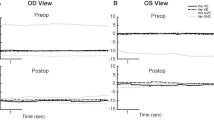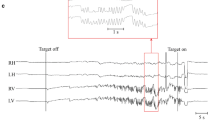Abstract
We recorded eye movements in 5 patients with latent nystagmus (LN) before and after 2 days of occlusion of the better eye. The slow-phase speed of the nystagmus (SPS) was in general, before occlusion, lower when the better eye fixated but, after occlusion, lower when the worse eye fixated. However, the sum of SPS during right fixation and SPS during left fixation remained constant. Oscillopsia complaints gradually disappeared during the period of occlusion. These findings indicate that the difference between the SPS during fixation with the right eye and the SPS during fixation with the left eye in LN patients is caused by a compensatory drift that decreases LN during fixation with the better eye but increases LN during fixation with the worse eye. During occlusion, this compensatory drift changes its direction and magnitude slowly over days. Hence, occlusion of the better eye in children with amblyopia and LN should be prescribed only in days per week, not in hours per day.
Similar content being viewed by others
References
Baumeister E. Klinische mededeelingen. III. Invloed van de houding van het hoofd bij de gezichtsscherpte bij nystagmus. Fifteen yearly report concerning nursing and education in the Dutch Clinic for Eye-patients (Scientific suppl.), Donders FC (ed.). Utrecht: Van de Weijer, 1874: 71–3.
Dell-Osso LF, Schmidt D, Daroff RB. Latent, manifest latent, and congenital nystagmus. Arch Ophthalmol 1979; 97: 1877.
Dell'Osso LF, Abel LA, Daroff RB. Latent/manifest nystagmus reversal using an ocular prosthesis. Invest Ophthalmol 1987; 28: 1873–6.
Estes MS, Blanks RHI, Markham CH. Physiological characteristics of first-order canal neurons in the cat. I. Response plane determination and resting discharge characteristics. J Neurophysiol 1978; 38: 1232–49.
Henn V, Young LR, Finley C. Vestibular nucleus units in alert monkeys are also influenced by moving visual fields. Brain Res 1974; 71: 144–9.
Kommerell G. Ocular motor phenomena in infantile strabismus. In: ‘Strabismus and amblyopia’, Proc Int Symp Wenner-Gren Center, Stockholm, June 24–26th, 1987. Lennerstrand G, von Noorden GK, Campos EC (eds.). Macmillan Press, 1988: 99–109.
von Noorden GK, Avilla C, Sidikaro Y, LaRoche R. Latent nystagmus and strabismic amblyopia. Am J Ophthalmol 1987; 103: 87–9.
Ohm J. Der latente Nystagmus im Stockdunkeln. Arch f Augenheilk 1928; 99: 417–37.
Percahio AA, Carreia MJ: Responses of semicircular canal and otolith afferents to small static angle head tilts in the gerbil. Brain Research 1983; 280: 287–98.
Robinson DA, Zee DS, Hain TC, Holmes A, Rosenberg LF. Alexander's Law: Its behavior and origin in the human vestibulo-ocular reflex. Ann Neurol 1984; 16: 714–22.
Roelofs, CO. Nystagmus latens. Arch f Augenheilk 1927; 98: 401–47.
Viirre E, Cadera W, Vilis T. The pattern of changes produced in the saccadic system and vestibulo-ocular reflex by visually patching one eye. J of Neurophys 1987; 57: 92–103.
Viirre E, Cadera W, Vilis T. Monocular adaptation of the saccadic system and vestibulo-ocular reflex. Invest Ophthalmol 1988; 29: 1339–47.
van Vliet AGM. Nystagmus latens. Ph.D. thesis, Leiden, 1966.
van Vliet AGM. On the central mechanism of latent nystagmus. Acta Ophthalmol 1973; 51: 772–81.
Author information
Authors and Affiliations
Rights and permissions
About this article
Cite this article
Simonsz, H.J. The effect of prolonged monocular occlusion on latent nystagmus in the treatment of amblyopia. Doc Ophthalmol 72, 375–384 (1989). https://doi.org/10.1007/BF00153506
Accepted:
Issue Date:
DOI: https://doi.org/10.1007/BF00153506




